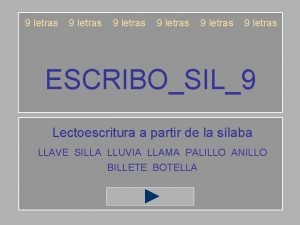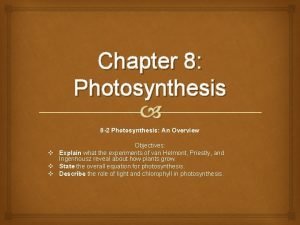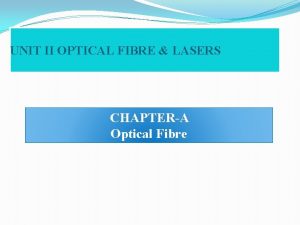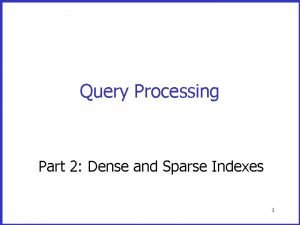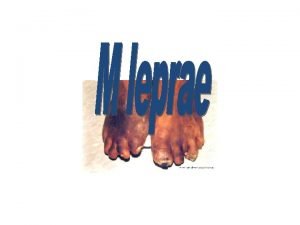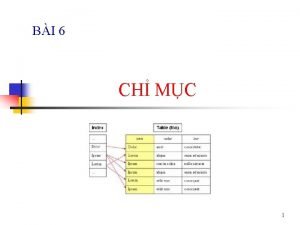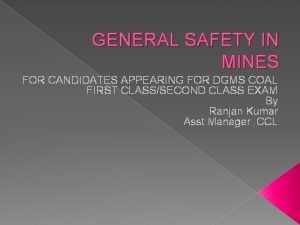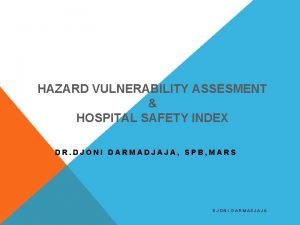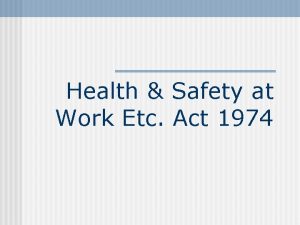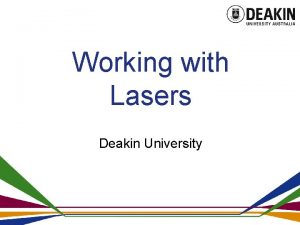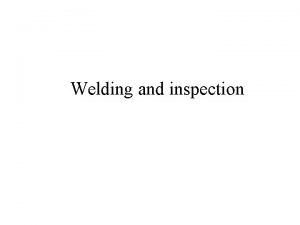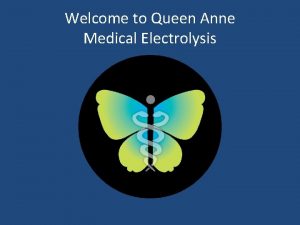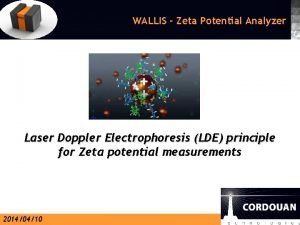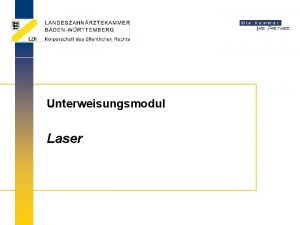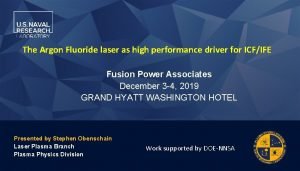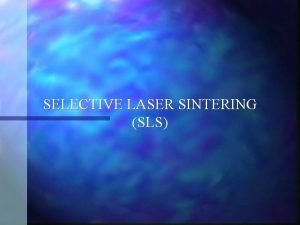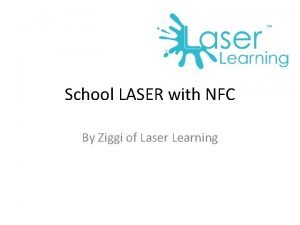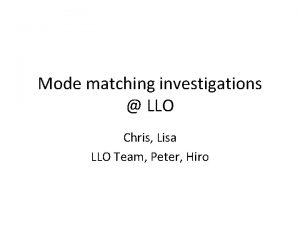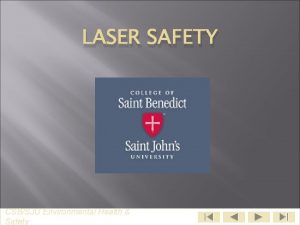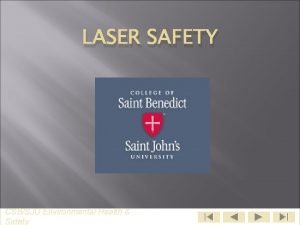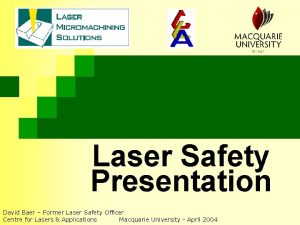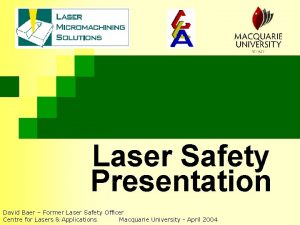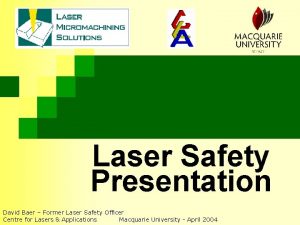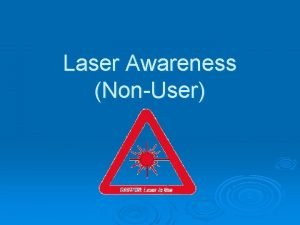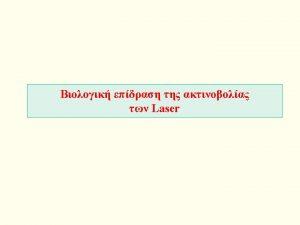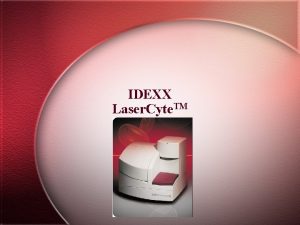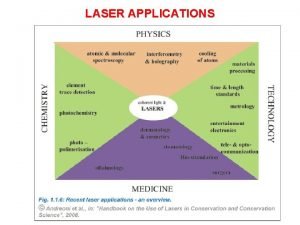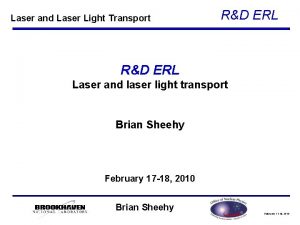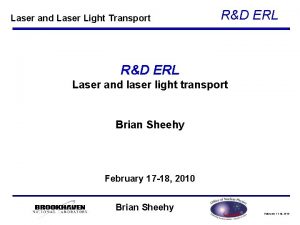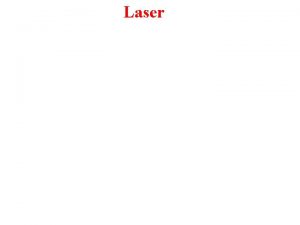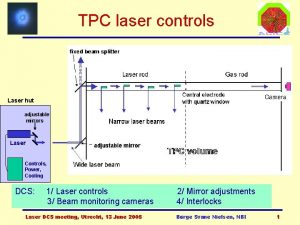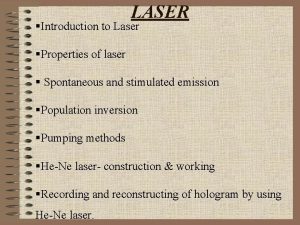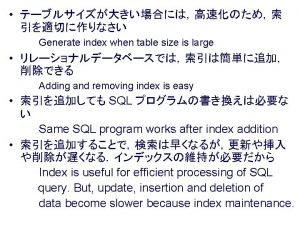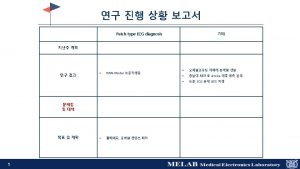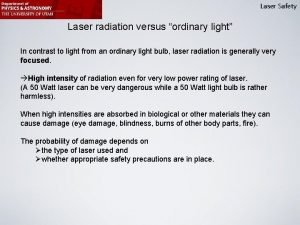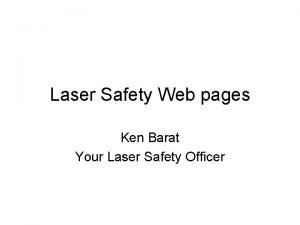LLO Laser Safety Overview Index Section 1 LLO




























- Slides: 28

LLO Laser Safety Overview Index Section 1: LLO Nominal Hazard Zones (NHZs) Section 2: LLO Laser Hazard Lights Section 3: LLO ESTOPs Section 4: LLO Laser Safety Eyewear LIGO-G 1400808 -V 2 1

Section 1 - LLO Nominal Hazard Zones (NHZs) << Index There are 9 Nominal Hazard Zones (NHZs) that are semi-permanent features of the LLO facility. These include: 1. HPLF – The High Power Laser Facility run by the University of Florida 2. THE DETECTOR – The LVEA, VEAX, VEAY, LDR, and LAE (PSL) 3. LVEA – The Laser and Vacuum Equipment Area 4. LDR and LAE (PSL) – The Laser Diode Room and the Laser Area Enclosure 5. Optics Lab – Corner Station 6. Optics Lab – X-End Station 7. Optics Lab – Y-End Station 8. VEAX – The Vacuum Equipment Area at the X-End Station 9. VEAY – The Vacuum Equipment Area at the Y-End Station 3 2 1 4 5 6 LIGO-G 1400808 -V 2 7 8 9 2

LAE (PSL) and LDR Transition to Laser Safe Both of the following conditions must be met. 1) The PSL laser must be off (M 1100038). 2) NO OTHER LASER located in the NHZ may be ON. NOTE: It is possible for this NHZ to be laser safe when the LVEA is laser hazard. LIGO-G 1400808 -V 2 3

LVEA Transition to Laser Safe ALL THREE (3) of the following conditions must be met. 1) The PSL INJECTION into the BEAM TUBE must be laser safe. The PSL laser must be off (M 1100038) Or the light pipe between the PSL Enclosure and HAM 1 must be locked closed (M 1100038) 2) The LVEA TABLES must be laser safe. TCSBT 1 R must be laser safe (M 1300206) (TCSY Laser locked OFF with key removed and in KEYBOX) And TCSBT 3 L must be laser safe (M 1300206) (TCSX Laser locked OFF with key removed and in KEYBOX) And TCSHT 4 R must be laser safe (M 1300458) (HARTMANN SLEDs locked OFF with key removed and in KEYBOX) 3) NO OTHER LASER located in the LVEA may be ON. NOTE: ONLY when the LVEA is laser safe can VEAX or VEAY be transitioned to laser safe. NOTE: It is possible for the LVEA to be laser safe while VEAX or VEAY or both are laser hazard. LIGO-G 1400808 -V 2 4

VEAX Transition to Laser Safe ALL THREE (3) of the following conditions must be met. 1) The LVEA must be laser safe. 2) The VEAX lasers must be laser safe. Both PCALX (M 1300574) (PCALX Laser locked OFF with key removed and in KEYBOX) And ISCBT 4 L (ISCTEX) (M 1300551) (ALS-X Laser locked OFF with key removed and in KEYBOX) 3) NO OTHER LASER located in the VEAX may be ON. NOTE: It is possible for VEAX to be laser hazard when the LVEA is laser safe. LIGO-G 1400808 -V 2 5

VEAY Transition to Laser Safe ALL THREE (3) of the following conditions must be met. 1) The LVEA must be laser safe. 2) The VEAY lasers must be laser safe. Both PCALY (M 1300574) (PCALY Laser locked OFF with key removed and in KEYBOX) And ISCBT 5 R (ISCTEY) (M 1300551) (ALS-Y Laser locked OFF with key removed and in KEYBOX) 3) NO OTHER LASER located in the VEAY may be ON. NOTE: It is possible for VEAX to be laser hazard when the LVEA is laser safe. LIGO-G 1400808 -V 2 6

LAE (PSL) and LDR Transition to Laser Hazard The following conditions must be met before laser light is introduced into the NHZ. 1) The LDR Entrance Door LASER HAZARD LIGHT must be switched to HAZARD. 2) Personnel in the LDR and the LAE (PSL) must be made aware of the transition and must be equipped with the appropriate eyewear. NOTE: It is possible for the LAE (PSL) and LDR to be laser hazard when the LVEA is laser safe. LIGO-G 1400808 -V 2 7

LVEA Transition to Laser Hazard ALL Four (4) of the following conditions must be met before laser light is introduced into the beam tube. 1) 2) 3) 4) The LVEA Entrance Door LASER HAZARD LIGHT must be switched to HAZARD. The VEAX Entrance Door LASER HAZARD LIGHT must be switched to HAZARD. The VEAY Entrance Door LASER HAZARD LIGHT must be switched to HAZARD. Personnel in all of these NHZs must be made aware of the transition and must be equipped with the appropriate eyewear. NOTE: Normally, the LVEA cannot be made HAZARD unless the VEAX and the VEAY are made HAZARD as well. There are possible exceptions that require a work permit and permission of the LSO. LIGO-G 1400808 -V 2 8

VEAX Transition to Laser Hazard The following conditions must be met before laser light is introduced into the NHZ. 1) The VEAX Entrance Door LASER HAZARD LIGHT must be switched to HAZARD. 2) Personnel in the VEAX must be made aware of the transition and must be equipped with the appropriate eyewear. NOTE: The VEAX must be HAZARD before the LVEA is. NOTE: It is possible for VEAX to be laser hazard when the LVEA is laser safe. NOTE: ONLY the designated GREEN-LIGHT-SAFE eyewear is allowed in the VEAX. LIGO-G 1400808 -V 2 9

VEAY Transition to Laser Hazard The following conditions must be met before laser light is introduced into the NHZ. 1) The VEAY Entrance Door LASER HAZARD LIGHT must be switched to HAZARD. 2) Personnel in the VEAY must be made aware of the transition and must be equipped with the appropriate eyewear. NOTE: The VEAY must be HAZARD before the LVEA is. NOTE: It is possible for VEAY to be laser hazard when the LVEA is laser safe. NOTE: ONLY the designated GREEN-LIGHT-SAFE eyewear is allowed in the VEAY. LIGO-G 1400808 -V 2 10

LLO Laser SOPs (Most need reviewed) LIGO-M 960001: LIGO Laser Safety Program LIGO-M 080368: LLO NHZ Transition Procedures LIGO-M 1000236: LLO 8 W TCS SOP LIGO-M 1000230: LLO 35 W TCS SOP LIGO-M 1000233: LLO Crysta. Laser SOP LIGO-M 1000232: LLO Photon Calibrator SOP LIGO-M 1000295: LLO 40 m. W Fermionics Diode Laser SOP LIGO-M 1000229: LLO 35 W PSL SOP LIGO-M 1000235: LLO 200 m. W JDSU NPRO SOP LIGO-M 1100305: LLO Silica Fiber Welding Machine SOP LIGO-M 1100038: LLO 200 W PSL Installation SOP LIGO-M 1000231: LLO 100 W HPLF SOP LIGO-M 1000234: LLO 700 m. W Lightwave NPRO SOP LIGO-M 1200103: LLO 50 W TCS Laser SOP for use in the HPLF LIGO-G 1101139: Wave Plate Lockout-Tagout LIGO-G 1100150: LLO Safety Document Emphasis LIGO-M 1200126: LLO TMS 130 m. W Alignment Laser SOP LIGO-M 1200327: LLO 5 W Autocollimator SOP LIGO-G 1001060: a. LIGO Laser Safety Eyewear Requirements LIGO-M 1200279: LLO Input Mode Cleaner Commissioning SOP LIGO-M 040112: LIGO Livingston Observatory Laser Safety Plan (Obsolete) LIGO-M 1300458: Standard Operating Procedure for a. LIGO TCS HWS SLED LIGO-M 1300551: SOP for operating the Arm Length Stabilization at LLO LIGO-M 1300574: LLO PCAL SOP (Temporary) LIGO-M 1400006: LLO PRC Probe Laser SOP LIGO-E 1200231: Advanced LIGO TCS CO 2 Laser Projection System Hazard Analysis LIGO-M 1200041: IO Laser Power Control - Standard Operating Procedure LIGO-E 1000205: a. LIGO TCS HWS Hazard Analysis LIGO-M 1300206: Standard Operating Procedure for a. LIGO TCS 50 W CO 2 Lasers LIGO-G 1400808 -V 2 11

Section 2 - LLO Laser Hazard Lights << Index Laser Hazard Lights LIGO-G 1400808 -V 2 TYPE 1: ENTRANCES: 1. LVEA Entrance 2. AIRLOCK Entrance 3. LDR Entrance 4. LAE Entrance 5. OPTICS LAB Entrance 6. VEAX Entrance 7. X-END OPTICS LAB Entrance 8. VEAY Entrance 9. Y-END OPTICS LAB Entrance 10. HPLF Entrance TYPE 2: TABLES: 1. ISCHT 1 L (IMC) 2. IOHT 2 L 3. IOHT 2 R 4. ISCHT 6 R (OMC) 5. TCSHT 4 R (Hartmann) 6. TCSBT 1 R (TCS-Y) 7. TCSBT 3 L (TCS-X) 8. ISCBT 5 R (VEAY) 9. ISCBT 4 L (VEAX) 10. PCALX 11. PCALY 12

Types of Laser Hazard Lights Entrances Rockwell Laser Industries 7754 Camargo Rd Cincinnati OH 45243 Enclosures Rockwell Laser Industries 7754 Camargo Rd Cincinnati OH 45243 LIGO-G 1400808 -V 2 13

LVEA Laser Hazard Light at Entrances << Laser Hazard Lights ENTRANCES: 1. LVEA Entrance 2. AIRLOCK Entrance 3. LDR Entrance 4. LAE Entrance 5. OPTICS LAB 6. VEAX Entrance 7. X-END OPTICS LAB 8. VEAY Entrance 9. Y-END OPTICS LAB 10. HPLF Entrance Lights at ENTRANCES demark NOMINAL HAZARD ZONES (NHZ) where laser safety eyewear is required when the zone is in a HAZARD condition. LIGO-G 1400808 -V 2 14

LVEA Laser Hazard Light on Tables ISCBT 5 R TABLES: 1. ISCHT 1 L (IMC) 2. IOHT 2 L 3. IOHT 2 R 4. ISCHT 6 R (OMC) 5. TCSHT 4 R (Hartmann) 6. TCSBT 1 R (TCS-Y) 7. TCSBT 3 L (TCS-X) 8. ISCBT 5 R (VEAY) 9. ISCBT 4 L (VEAX) 10. PCALX 11. PCALY ISCHT 1 L IOHT 2 L TCSHT 4 R IOHT 2 R TCSBT 1 R Lights on a TABLE ENCLOSURE indicate the condition of the integrity of that table enclosure. If a table is closed, then that table cannot contribute any possible laser hazard. If a table is open, then that table might contribute a possible hazard. TCSBT 3 L PCALX ISCBT 4 L ISCHT 6 R LIGO-G 1400808 -V 2 15

Section 3 - LLO Laser ESTOPs << Index Suppose there is a problem that demands that all the lasers be shut off … right now. LIGO-G 1400808 -V 2 16

LLO Laser ESTOP Requirement "Push one of these buttons and the lasers are off. “ - Joe Giaime EMERGENCY LASER ESTOP LIGO-G 1400808 -V 2 17

LLO ESTOP Corner Building Locations ESTOP buttons are RED mushroom buttons marked EMERGENCY STOP. They are located in a variety of places. If any ESTOP is pressed, all detector lasers lose their interlocks and cease lasing. These lasers are the PSL, TCS-X CO 2, TCS-Y CO 2, and the Hartmann SLEDs. In addition, when a Corner Station ESTOP is pressed, the LVEA entrance door, the LVEA AIRLOCK door, and the LDR door will be unsecured allowing them to be opened from the outside without using access cards. ISCHT 1 L LAE (PSL) Air Shower Entrance 6 5 10 8 TCSBT 3 L 7 IOHT 2 R 2 Control Room TCSBT 1 R IOHT 2 L 1 11 12 TCSHT 4 R 4 LDR Entrance Door LVEA AIRLOCK Door LVEA Entrance Door 3 a 3 b 9 ISCHT 6 R Button Types 1. Table 2. Entrance LIGO-G 1400808 -V 2 18

Table Button Type (Standard Access Box) There is a Standard Access Boxes on each table enclosure, plus one at the entrance to the LAE (PSL) Air Shower. An ESTOP Button is provided on each Standard Access Box. LIGO-G 1400808 -V 2 19

Entrance Button Type There is an ESTOP Button in the control room beside the key box. LIGO-G 1400808 -V 2 20

Entrance Button Type There also ESTOP Buttons strategically located at entrance doors. There is an ESTOP Button at the LVEA entrance door. There is an ESTOP Button at the LARGE AIRLOCK entrance door. There is an ESTOP Button at the LDR entrance door. There is an ESTOP Button inside the LDR. LIGO-G 1400808 -V 2 21

What Happens If … If an ESTOP is pressed: The ESTOP that was pressed causes the latching circuit to unlatch, causing all of the interlocks to be disengaged, causing the various lasers to cease lasing. The ESTOP that was pressed must itself be reset before the ESTOP Control Box is capable of being reset. An ESTOP Event must be thoroughly investigated by the LSO before any further work can proceed. It is a mandatory ‘STOP WORK’. If there is a POWER FAILURE: The ESTOP Control Box will lose power, causing the latching circuit to unlatch, causing all of the interlocks to be disengaged, causing the various lasers to cease lasing. As part of the recovery from a power failure, the ESTOP Control Box must be reset before any laser can be recovered. LIGO-G 1400808 -V 2 22

Corner Station ESTOP Control Box - OFF The Corner Station ESTOP Control Box is located in the MSR. When the Laser Enabled LED (Yellow) is OFF, lasers are prevented from lasing. LIGO-G 1400808 -V 2 23

Corner Station ESTOP Control Box - Controls To enable the lasers, the ESTOP Control Box must be reset. RESET Switch (Keyed) (Momentary) AC On/Off Switch TEST Switch (Keyed) (Maintained) AC 10 A Fuse LIGO-G 1400808 -V 2 Note: If the Power On LED (Green) is not lit, consider: 1) the On/Off Switch 2) the Fuse 3) The Circuit Breaker 24

Corner Station ESTOP Control Box When the Laser Enabled LED is ON, lasers are not prevented from lasing. Note: This does NOT mean any laser is on. LIGO-G 1400808 -V 2 25

ESTOPs and Laser Hazard Lights indicate the status of a Nominal Hazard Zone (NHZ). When an NHZ is HAZARD, laser safety eyewear is required. The status of an NHZ is not based on the actual presence of a laser hazard. Instead, the status is defined by a transition and is signaled by the zone’s Laser Hazard Lights. Although an ESTOP Event causes all controlled lasers to cease lasing, it will not change the status of the NHZ, that is, it will not change the state of any Laser Hazard Light. During an ESTOP Event, one of the first things that must be decided is whether or not to transition the NHZ. This is a manual procedure precisely because there may be mitigating circumstances, and because other actions to insure a safe NHZ cannot be automated. LIGO-G 1400808 -V 2 26

LLO Laser Safety Eyewear << Index Laser Safety Eyewear is the Personal Protection Equipment required to be worn by any person who enters a Nominal Hazard Zone (NHZ) NHZ is HAZARD. There are three categories of Laser Safety Eyewear that correspond to the hazardous frequencies that are present in various NHZs. ALL Laser Safety Eyewear is marked according to Category J is for all frequencies in the LVEA. Category K is for all frequencies in the PSL and LDR. Category M is for all frequencies in the VEAX and VEAY. Some helpful suggestions: • Be sure the eyewear you use is correct for the area you are entering. • Compare the OD written on the eyewear with the OD requirements on the laser hazard signs. • Clean the eyewear from time to time. • Inspect the eyewear for structural and optical integrity. • Return the eyewear to where you got it. LIGO-G 1400808 -V 2 27

LLO Laser Safety Eyewear Categories << Laser Safety Eyewear Category J is for all frequencies in the LVEA ONLY. These are: 150 m. W @ 900 nm (Hartman) (OD 2. 2) 150 m. W @ 950 nm (Hartman) (OD 2. 1) 200 W @ 1064 nm (PSL) (OD 5. 1) 80 W @ 10, 600 nm (TCS) (OD 4. 0) Category K is for all frequencies in the PSL and LDR. These are: 315 W @ 808 nm (PSL Pump Diodes) (OD 5. 7) 200 W @ 1064 nm (PSL) (OD 5. 1) (NOTE: One must walk through the LVEA to get to the PSL, so for convenience, Category K eyewear also cover the LVEA frequencies. ) Category M is for all frequencies in the VEAX and VEAY. These are: 50 m. W @ 532 nm (ALS) (OD 2. 2) 500 m. W @ 1047 nm (Photon Calibrators) (OD 2. 5) 200 W @ 1064 nm (PSL, ALS is only 1. 5 W) (OD 5. 1) (NOTE: Category M will also cover ALL frequencies in ALL NHZs, but they are harder to see through. LIGO-G 1400808 -V 2 28
 Santo hermano miguel biografía
Santo hermano miguel biografía Dictado con lla lle lli llo llu
Dictado con lla lle lli llo llu Chapter 8 section 2 photosynthesis answer key
Chapter 8 section 2 photosynthesis answer key Optical fibre
Optical fibre Primary index is dense or sparse
Primary index is dense or sparse Mycobacterium leprae
Mycobacterium leprae Physical quality of life index and human development index
Physical quality of life index and human development index Fibers
Fibers How to calculate simpson's diversity index
How to calculate simpson's diversity index Consistency index and liquidity index
Consistency index and liquidity index Clustered index và non clustered index
Clustered index và non clustered index Safety index formula
Safety index formula Hazard vulnerability
Hazard vulnerability Safety depth formula in ecdis
Safety depth formula in ecdis Safety care certification
Safety care certification Process safety vs personal safety
Process safety vs personal safety Safety assessment for ind safety reporting
Safety assessment for ind safety reporting Basic safety construction site safety orientation
Basic safety construction site safety orientation Construction site safety orientation
Construction site safety orientation Health and safety at work etc act 1974 section 2
Health and safety at work etc act 1974 section 2 What is a class iii laser
What is a class iii laser Laser weld symbol
Laser weld symbol Queen anne medical electrolysis and laser
Queen anne medical electrolysis and laser Laser doppler electrophoresis
Laser doppler electrophoresis Betriebsanweisung laser
Betriebsanweisung laser Argon fluoride laser to practical fusion
Argon fluoride laser to practical fusion Selective laser sintering disadvantages
Selective laser sintering disadvantages Lhpa laser
Lhpa laser Spiking in ruby laser
Spiking in ruby laser

